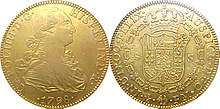Doubloon
The doubloon (from Spanish doblón, meaning "double") was a two-escudo or 32-real gold coin,[1] weighing 6.867 grams (0.218 troy ounces) in 1537, and 6.766 grams from 1728, of .917 fine gold (22-carat gold).[2] Doubloons were minted in Spain and the viceroyalties of New Spain, Peru, and Nueva Granada (modern-day Colombia, Ecuador, Panama, and Venezuela). The term was first used to describe the golden excelente either because of its value of two ducats or because of the double portrait of Ferdinand and Isabella.

In the New World, Spanish gold coins were minted in one, two, four, and eight escudo denominations. The two-escudo piece was called a "pistole"; the large eight-escudo coin was called a "quadruple pistole" or, at first, a double doubloon. English colonists would come to call it the Spanish doubloon.[2]
After the War of 1812, doubloons were valued in Nova Scotia at the rate of £4 and became the dominant coin there.[3]
Doubloons marked "2 S" are equivalent to four dollars in US gold coins and were traded in that manner. Small 1/2-escudo coins (similar to a US $1 gold piece) have no value marked on them but were worth a Spanish milled dollar in trade.
In Spain, doubloons were current up to the middle of the 19th century. Isabella II of Spain replaced an escudo-based coinage with decimal reales in 1859, and replaced the 6.77-gram doblón with a new heavier doblón worth 100 reales and weighing 8.3771 grams (0.268 troy ounces). The last Spanish doubloons (showing the denomination as 80 reales) were minted in 1849. After their independence, the former Spanish Viceroyalties of Mexico, Peru and Nueva Granada continued to mint doubloons.
In other countries
Doubloons have also been minted in Portuguese colonies, where they went by the name dobrão, with the same meaning. The São Tomé and Príncipe dobra is the only extant currency with a name meaning "doubloon."
In Europe, the doubloon became the model for several other gold coins, including the French Louis d'or, the Italian doppia, the Swiss duplone, the Northern German pistole, and the Prussian Friedrich d'or.
In present-day Canada, "doubloon" is occasionally used to describe to the |Canadian two-dollar coin (the one-dollar coin is nicknamed the loonie, owing to it's use of a Common loon on it's reverse).
See also
- Spanish dollar, also known as a piece of eight
- Brasher Doubloon
- Moby Dick Coin
References
- "Doubloon". Dictionary.com.
- "Spanish Gold: Introduction".
- McCullough, Alan Bruce. Money and Exchange in Canada to 1900, Dundurn, 1984 ISBN 9780919670860